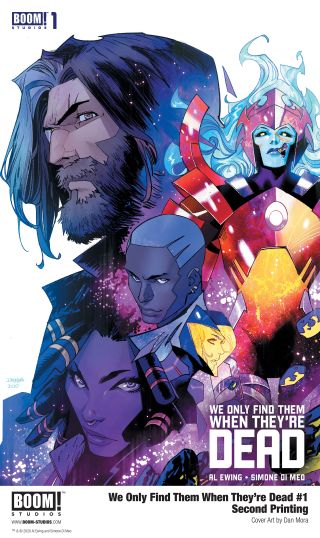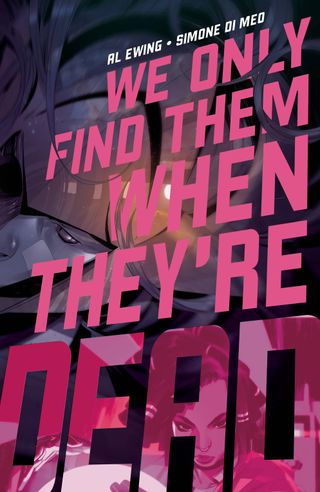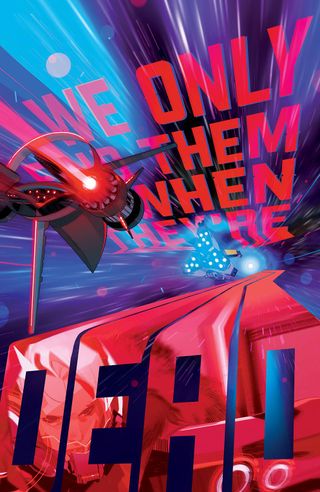Looking for space gods in We Only Find Them When They're Dead by Al Ewing & Simone Di Meo
We Only Find Them When They're Dead a 15-issue sci-fi, philosophical epic

Al Ewing rose to fame by transforming Marvel's 'incredible' Hulk into the cosmic horror of Immortal Hulk, and now he's taking that into the creator-owned cosmos to hunt down gods with We Only Find Them When They're Dead.

The 'them ' in the name 'We Only Find Them When They're Dead' refers to gods that the near-future Earth society of 2367 and their multiple discoveries of dead alien gods in space, and the process for harvesting those corpses for resources. But with all that comes with scavenging dead gods, imagine if they were to find one still alive?
With We Only Find Them When They're Dead #1 due out September 2, Newsarama spoke with Ewing and co-creator/artist Simone Di Meo about the grizzly job of mining the bodies of dead gods, the deeper obsession of the crew's captain, and how they themselves found each other to work at Boom! Studios on this series.
Newsarama: Al, you’ve been doing a lot of work with Marvel, what made you want to jump into the indie space again?

We Only Find Them When They're Dead #1 preview



Al Ewing: Any shared fictional universe is a vast machine of moving parts and different story gravities, and everything you do has to navigate this very crowded environment. It's as if the characters themselves exert a pull on the narrative, deforming it in certain ways.
If I create my own universe, and my own characters, with Simone bringing them to life, that means I'm a lot freer to do exactly what I want with them, and some stories can only really be told that way - this was one of them.
Nrama: Why did you think Boom! was the perfect place for a story like We Only Find Them When They’re Dead?
Comic deals, prizes and latest news
Get the best comic news, insights, opinions, analysis and more!

Ewing: A few of my favorite comics have been done via Boom! - I was a big fan of Giant Days and Midas Flesh, and I'm enjoying Once & Future a lot.
I've been carrying this idea around for a while, and Boom! was helpful getting it to a stage where it could actually exist, rather than being something I chatted at conventions about with artists who weren't available. I've learned a lot from this experience that I'll hopefully be able to apply down the road.
Nrama: How did you connect with Simone for the project?
Ewing: Boom! put us in touch!
I needed an artist for this - not just someone to draw it, but someone to bring a sense of location and design, a co-creator. And I'd worked with Simone before on an Immortal Hulk one-shot that went very well, so I knew I enjoyed working with him, so that was ideal.
We could have actually gone elsewhere with it if things had shaken out differently - we did a general pitch of the first book in the cycle to show people - but since then, it's expanded into something bigger, partly because I knew Simone can handle it. His art is one of the massive draws for this series.
Nrama: One thing that really grabbed me about this story is that it feels like a reversal of your average alien abduction narrative. Instead of the aliens dissecting us, it’s the other way around. What interested you about that concept?
Ewing: That's certainly one way of looking at it - personally, though, I see the gods in the narrative less as big aliens and more as gods, theological beings.
As we get closer to them, leaving our space and moving into theirs, we get to see that more. That's the concept that interests me, I think - using these great science-fiction metaphors for the search for meaning. It feels like part of a tradition of using science fiction to examine these big philosophical questions.

Nrama: What made you want to tell a sci-fi adventure?
Ewing: Sci-fi's where I got my start, in a lot of ways, as a writer and also as a reader - the first 'serious' comic I ever bought was 2000AD, the great British sci-fi anthology - they're still going strong after all these years, and for six months out of the year they accept unsolicited submissions according to their guidelines, so if you're a new writer looking for a place to sell a story, I'd check their website.
But it's not just comics - I read a lot of books as a child, and there was a lot of SF stuff in that mix. We had a bunch of the old Spectrum SF short story collections on the shelves, and I ate through those. So, I've wanted to tell something in the traditions of the SF New Wave for a while now, and this is it.
Nrama: What can you tell us about the characters?
Ewing: Let's start with Captain Malik - he's a haunted, obsessive figure, someone who's endured some terrible hardships in his life. As we find out more about him and his world, his quest to see and know a God will make more sense.
His oldest friend is Alice Wirth, the quartermaster, who's balanced him for years as a more happy-go-lucky figure - she runs the hold, packing the meat and other goodies as they're carved off the immense corpses.
Doing the cutting is Ella Hauer, the coroner, who works in the coroner's suite - a kind of gun emplacement under the ship that fires off a laser "knife" that can cut through the Gods' armor and flesh.
She hasn't had much opportunity for a life of her own - she's spent most of it looking after her brother Jason Hauer, the engineer, who runs communications and monitors the repair functions. He's grown reckless, chafing a little under his sister's authority - he might seem shallow at first, but as we spend more time with him (and we will) we'll get to see what's under the surface.
And finally, we have Paula Richter, who's Simone's favorite character - a hard-nosed, brutal security officer with an old grudge against Malik. Her obsession mirrors his.

Nrama: Simone, let's bring you in now - how did you come up with the character designs for the book?
Simone Di Meo: I love almost everything I had to work on for this universe.
I’m a big fan of sci-fi, astronomy, and being able to create a new universe has been incredible and continues to be.
If I had to say one part that I loved a lot was the creation of the designs for the dead gods, I really worked hard on it trying to find an iconic, divine and elegant solution, I hope I succeeded!
Nrama: What’s been your favorite aspect from the world to draw thus far?
Di Meo: I don't think I'll forget the moment when Al asked me to be part of the project, we worked together on a one-shot for Immortal Hulk and after a couple of months he wrote to me to propose an idea he wanted to develop, I found it brilliant and I loved it after the first words, I immediately accepted.
I couldn't start working on it right away, due to some commitments to complete earlier, but Boom! Studios, after having loved the project and agreed to develop it, gave me time to finish the rest, before starting work.
I couldn't be happier to have accepted this adventure.
Nrama: For fans of your Marvel work, what do you think they’ll enjoy about this title?
Ewing: If you like Immortal Hulk or Guardians of the Galaxy, this has similar concerns - not so much the body horror or the superheroic aspects, but more the scope and scale, the character work, and the exploration of ideas through poetic and visual metaphor.
Nrama: Simone, you’ve done a lot of work with Boom!, especially with Power Rangers. Your Mighty Morphin Power Rangers run, in particular, was very space driven. Are there any relatable elements with We Only Find Them When They’re Dead and Power Rangers?
Di Meo: Yes, I’ve been collaborating with the Boom! team for a few years now, working with them is always great and I love their energy.
My experience on Power Rangers was really important, it was my first run on a regular series, it taught me the true spirit of serial comics and I had to create a lot of designs and a new universe there, just like I did for We Only Find Them When They’re Dead.

An element in particular that can be found on the Power Rangers and on We Only Find Them When They’re Dead, is the nebula texture found on the Solar Ranger suit is the same that can be found on the armor of the dead Gods, it’s an element that I find really cosmic and from an idea of my editor, Eric, we were able to use it!
Nrama: Al, before we go - do you have a certain amount of issues you'd like We Only Find Them When They’re Dead to run for?
Ewing: 15. And we have 15. So that's good. This isn't a book where we're worried about getting canceled or trying to not get canceled - this is a book where we have a particular story to tell, and we're going to tell it.
There are three books, three acts, a beginning, a middle, and an end. And after that, we'll have built a world - several worlds - and we can go back to that setting if we have the urge, or even let other people play in that space. Why not? A lot of the great SF novels have sequels.
Kat has been working in the comic book industry as a critic for over a decade with her YouTube channel, Comic Uno. She’s been writing for Newsarama since 2017 and also currently writes for DC Comics’ DC Universe - bylines include IGN, Fandom, and TV Guide. She writes her own comics with her titles Like Father, Like Daughter and They Call Her…The Dancer. Calamia has a Bachelor’s degree in Communications and minor in Journalism through Marymount Manhattan and a MFA in Writing and Producing Television from LIU Brooklyn.
Most Popular

